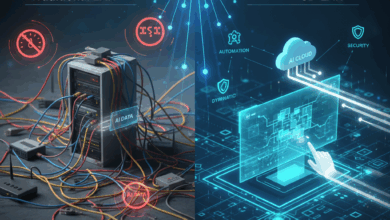Guide to the CISA Zero Trust Model covers everything you need to know about this popular framework.
In the modern cybersecurity landscape, “Zero Trust” has evolved from a buzzword into a critical strategic imperative. It’s the philosophy that no user, device, or network component should be inherently trusted, regardless of its location.
As we navigate mid-2025, one of the most impactful and widely adopted frameworks guiding this transition is the CISA Zero Trust Model.
Developed by the Cybersecurity and Infrastructure Security Agency (CISA) in the United States, this model serves as a practical roadmap. It helps organizations, particularly government agencies, assess their current security posture and progressively adopt Zero Trust principles.
While initially designed for U.S. federal agencies, its comprehensive nature and clear structure have made it a valuable guide for public and private sector organizations worldwide, including those in the UK and Europe.
Core Philosophy of the CISA Zero Trust Model
At its heart, the CISA Zero Trust Model provides a structured approach to implementing Zero Trust Architecture (ZTA). It aims to minimize uncertainty in enforcing accurate, least-privilege, per-request access decisions.
The underlying assumption is always that the network is already compromised or that a threat could originate from anywhere, internal or external.
The model is built around five key pillars and three cross-cutting capabilities.
These elements work in concert to shift an organization’s security posture from a traditional, perimeter-based defense to a more data-centric, identity-aware approach. It’s about securing assets wherever they reside, rather than just the network boundary.
The CISA model is often used in conjunction with NIST Special Publication 800-207, which provides the foundational definition of Zero Trust Architecture.
CISA’s contribution is a practical maturity model that outlines a journey through different stages of Zero Trust adoption.
Five Pillars of the CISA Zero Trust Model
The CISA model divides Zero Trust implementation into five interconnected pillars, each representing a crucial area for security focus.
1. Identity
This pillar focuses on ensuring that all users, services, and applications accessing resources are verified and continuously authenticated. It’s about more than just a password; it involves strong, phishing-resistant multi-factor authentication (MFA) and continuous monitoring of identity attributes.
In practice, this means adopting solutions like Okta Workforce Identity Cloud for robust authentication or implementing government-mandated phishing-resistant MFA (e.g., FIDO2 keys).
The goal is to move from relying on single sign-on with weak credentials to dynamic, risk-based identity verification at every access point.
2. Devices
The Devices pillar is all about assessing and maintaining the security posture of every device attempting to access resources. This includes laptops, mobile phones, servers, IoT devices, and even network infrastructure.
Organisations must have a comprehensive inventory of all devices, ensure they are managed, patched, and compliant with security policies before granting access.
Tools like Microsoft Defender for Endpoint or CrowdStrike Falcon Insight are critical here, providing real-time device health assessments and vulnerability management. This pillar also emphasizes controlling what resources a device can access based on its verified security status.
3. Network/Environment
This pillar moves away from traditional network segmentation (like VLANs) towards micro-segmentation. The aim is to create smaller, isolated network segments to restrict lateral movement of attackers.
Traffic monitoring within these segments is paramount. Implementing Software-Defined Networking (SDN) and micro-segmentation platforms like Illumio Core or VMware NSX are key here.
This also involves securing all communications, regardless of network location, by encrypting traffic between segments and continuously inspecting it for threats.
4. Application Workload
The Application Workload pillar focuses on securing enterprise applications and their underlying components. This means ensuring that access to applications is dynamically controlled, based on user and device context, and that applications themselves are secure.
It involves incorporating security into the application development lifecycle (DevSecOps) and utilizing API security gateways.
Solutions like F5 BIG-IP Advanced WAF or Imperva App Protect help secure web applications, while API gateways from vendors like Apigee (Google Cloud) or Kong control and secure API interactions, which are often the backbone of modern applications.
5. Data
This pillar emphasizes protecting sensitive data regardless of its location or state (at rest, in transit, in use). It involves data classification, encryption, and strict access controls. Data Loss Prevention (DLP) solutions are crucial for preventing unauthorized data exfiltration. Forcepoint DLP or Symantec DLP are examples of tools used to monitor and protect sensitive data. The focus is on granular access policies tied directly to data sensitivity, ensuring that only authorized entities with validated identities and secure devices can access specific data sets.
The Foundation of CISA’s Model
Beyond the five pillars, the CISA Zero Trust Model highlights three “cross-cutting” capabilities that are essential for successful implementation and maturity across all pillars.
1. Visibility and Analytics
This involves collecting comprehensive telemetry from all pillars – identity, devices, networks, applications, and data. This data is then analyzed using advanced tools, often including AI and machine learning, to gain situational awareness, detect anomalous behavior, and identify potential threats in real time. Splunk Enterprise Security or Sentinel (Microsoft Azure) are examples of platforms that provide this centralised visibility and analytical power.
2. Automation and Orchestration
To manage the complexity of Zero Trust at scale, automation is crucial. This capability involves integrating security tools across different pillars and automating security workflows, policy enforcement, and incident response. It allows for dynamic policy adjustments based on real-time threat intelligence or behavioral anomalies. SOAR platforms from vendors like Palo Alto Networks XSOAR or IBM Resilient exemplify this capability, automating responses to security events.
3. Governance
This ensures that the Zero Trust strategy is aligned with organizational goals, compliance requirements, and risk management frameworks. It involves establishing clear policies, roles, responsibilities, and ongoing audits. Robust governance ensures the Zero Trust program is continuously improved and adapts to evolving threats and business needs.
CISA Zero Trust in Practice: A Phased Maturity Journey
The CISA Zero Trust Model isn’t a “rip and replace” mandate; it’s a maturity model with four stages: Traditional, Initial, Advanced, and Optimal. Organizations assess where they currently stand and develop a phased plan to progress.
Traditional
This represents the legacy state, relying on perimeter defenses and implicit trust.
Initial: Early stages of Zero Trust adoption, with some isolated changes like stronger MFA.
Advanced: More comprehensive integration of Zero Trust across multiple pillars, with some automation.
Optimal: Fully operational, highly automated, and adaptive Zero Trust architecture where all principles are integrated and continuously refined.
In practice, U.S. federal agencies are heavily influenced by the CISA model due to mandates from the Office of Management and Budget (OMB M-22-09).
This has spurred significant investment and strategic planning across departments like the Department of Defense (DoD) and various civilian agencies. They are actively implementing phishing-resistant MFA, enhancing endpoint detection and response (EDR), and segmenting networks, often starting with the Identity, Device, and Network pillars as foundational steps.
Agencies leverage vendors like Zscaler for Zero Trust Network Access (ZTNA) or Cloudflare for secure access, aligning directly with CISA’s guidance on securely connecting users to applications.
Global Popularity and Adoption
While originating in the U.S., the CISA Zero Trust Model’s practicality and clarity have garnered significant attention globally.
In the United Kingdom, while there isn’t a direct governmental mandate mirroring the U.S. executive orders, organizations are increasingly looking to frameworks like CISA’s and NIST’s for guidance.
The National Cyber Security Centre (NCSC) in the UK advocates strongly for principles aligned with Zero Trust, such as least privilege and continuous authentication. Many private sector enterprises in the UK, especially those dealing with sensitive data or operating internationally, are using the CISA model as a blueprint for their own Zero Trust transformations. Large financial institutions and critical national infrastructure providers are actively adopting these principles.
Across Europe, the CISA model, along with the broader NIST framework, serves as an important reference. Countries with strong cybersecurity initiatives, like Germany and the Netherlands, are emphasizing aspects such as identity verification, micro-segmentation, and data protection, all of which align with CISA’s pillars.
The NIS2 Directive, while not directly mandating CISA, pushes organiSations towards a higher level of cyber hygiene and resilience, for which Zero Trust, guided by models like CISA’s, provides a robust path. European cybersecurity vendors are also explicitly marketing their solutions’ alignment with CISA and NIST.
The model’s clarity and maturity stages make it appealing because it provides a structured way to approach a complex security paradigm. Organizations appreciate having a step-by-step guide to assess progress and prioritize investments, rather than facing a nebulous goal.
In essence, the CISA Zero Trust Model has become a critical navigational tool for organizations worldwide. It provides not just a definition, but a living, breathing guide to implementing Zero Trust, ensuring that security is woven into the fabric of the network, rather than bolted on as an afterthought.



